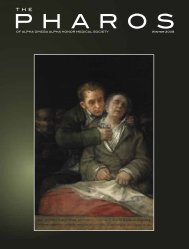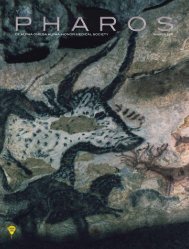The Pharos - Alpha Omega Alpha
The Pharos - Alpha Omega Alpha
The Pharos - Alpha Omega Alpha
Create successful ePaper yourself
Turn your PDF publications into a flip-book with our unique Google optimized e-Paper software.
imagined her mother eternally suffering<br />
the symptoms of each disease.<br />
p196<br />
<strong>The</strong> family’s religious background also<br />
influenced how they were able to perceive<br />
the “immortality” of the HeLa cell<br />
line.<br />
In that moment, reading those<br />
passages [in the Bible], I understood<br />
completely how some of the Lackses<br />
could believe, without doubt, that<br />
Henrietta had been chosen by the<br />
Lord to become an immortal being.<br />
. . .<br />
For Deborah and her family—and<br />
surely many others in the<br />
world—that answer was so much<br />
more concrete than the explanation<br />
offered by science: that the immortality<br />
of Henrietta’s cells had something<br />
to do with her telomeres and<br />
how HPV interacted with her DNA.<br />
<strong>The</strong> idea that God chose Henrietta<br />
as an angel who would be reborn<br />
as immortal cells made a lot more<br />
sense to them than the explanation<br />
Deborah had read years earlier in<br />
Victor McKusick’s genetics book. p296<br />
Ms. Skloot wrote the book for the<br />
lay public and integrates the science<br />
with the stories so that, while basic, it is<br />
never tedious.<br />
<strong>The</strong> book underscores the contradictions<br />
inherent in the benefits derived<br />
from a cell line developed from an uniformed<br />
patient without her consent.<br />
Even more reprehensible, HeLa was<br />
used in many further experiments on<br />
uninformed subjects. Like many doctors<br />
of his era, Henrietta’s surgeon, Dr.<br />
TeLinde, often used patients from the<br />
public wards for research, usually without<br />
their knowledge. Many scientists<br />
believed that since patients were treated<br />
for free in the public wards, it was fair<br />
to use them as research subjects as<br />
a form of payment. Most subjects, in<br />
keeping with the accepted racism of the<br />
time, were African American. In one<br />
notorious example out of many others,<br />
Chester Southam of Sloan-Kettering<br />
Institute for Cancer Research performed<br />
a number of studies to find out whether<br />
investigators of the cell line were at risk<br />
themselves of developing cancer from<br />
working with HeLa:<br />
In February 1954, Southam<br />
loaded a syringe with saline solution<br />
mixed with HeLa. He slid the<br />
needle into the forearm of a woman<br />
who’d recently been hospitalized for<br />
leukemia, then pushed the plunger,<br />
injecting about five million of<br />
Henrietta’s cells into her arm. Using<br />
a second needle, Southam tattooed<br />
a tiny speck of India ink next to<br />
the small bump that formed at the<br />
HeLa injection site. That way, he’d<br />
know where to look when he reexamined<br />
the woman days, weeks, and<br />
months later, to see if Henrietta’s<br />
cancer was growing on her arm. He<br />
repeated this process with about a<br />
dozen other cancer patients. He told<br />
them he was testing their immune<br />
systems; he said nothing about injecting<br />
them with someone else’s<br />
malignant cells.<br />
Such blatant ethical breaches contributed<br />
to efforts to create the requirements<br />
for informed consent and<br />
research oversight that now protect experimental<br />
subjects.<br />
<strong>The</strong> story of the author’s involvement<br />
with the family is a saga of incredible<br />
dedication. Skloot learned about<br />
HeLa at age sixteen in a community<br />
college biology class. Years later, when<br />
she contacted the family, she encountered<br />
great resistance. Once the identity<br />
of the donor of the HeLa cells had been<br />
revealed (twenty years after Ms. Lacks’<br />
death), the family was bombarded by requests<br />
for family details, blood samples,<br />
and information that could contribute<br />
to a good story. <strong>The</strong>y had been victimized<br />
by some, and felt that someone<br />
had made a fortune from their mother’s<br />
cells and that they should have a share.<br />
Skloot’s perseverance and personal sacrifice<br />
eventually won their trust.<br />
Read this book. It is a riveting story,<br />
a reminder of how far we have come<br />
and how far we have to go. It is not just<br />
about science or the life of a woman<br />
who died at such a young age. It is about<br />
truth and trust and breaches in professional<br />
responsibility. Deborah summarizes<br />
the conflict:<br />
“Truth be told, I can’t get mad at science,<br />
because it help people live, and<br />
I’d be a mess without it. I’m a walking<br />
drugstore! . . . But I won’t lie, I<br />
would like some health insurance so<br />
I don’t got to pay all that money every<br />
month for drugs my mother cells<br />
probably helped make.” p256<br />
Dr. Griffith is an associate professor in<br />
Community and Family Medicine at the<br />
University of Missouri—Kansas City<br />
School of Medicine. His address is:<br />
University of Missouri—Kansas City<br />
School of Medicine<br />
7900 Lee’s Summit Road<br />
Kansas City, Missouri 64139<br />
E-mail: griffithst@umkc.edu<br />
A CELEBRATION OF POETS<br />
Reviewed by Jack Coulehan, MD<br />
(AΩA, University of Pittsburgh, 1969)<br />
E<br />
veryone is aware of the dramatic<br />
advances in medical science that<br />
have occurred over the last few decades,<br />
but relatively few people realize that the<br />
medical profession has also experienced<br />
a parallel explosion of poetic creativity.<br />
Medicine has a long tradition of distinguished<br />
physician-poets, including,<br />
for example, Thomas Campion, Tobias<br />
Smollett, Oliver Goldsmith, John Keats,<br />
Oliver Wendell Holmes, Silas Weir<br />
Mitchell, Robert Bridges, and William<br />
Carlos Williams, the early twentiethcentury<br />
bard of Rutherford, New Jersey.<br />
Today’s American medical poets generally<br />
look to Williams as their godfather.<br />
His no-nonsense language, accurate observation,<br />
and privileging of experience<br />
over ideas meshes well with the ethos of<br />
<strong>The</strong> <strong>Pharos</strong>/Autumn 2012 39














